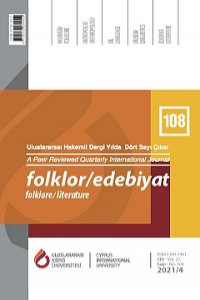Şenlik’in Salman Bey ve Turnatel Hanım Hikâyesi’nin Denis Bertrand’ın Anlatı İzlencesi Formülünde Okunması
Reading Şenlik’s Story of Salman Bey and Turnatel Hanım in Bertrand’s Narrative Curriculum Formula
Author(s): Fatma Pınar KuzuSubject(s): Semiotics / Semiology, Customs / Folklore, Turkish Literature, 19th Century, Theory of Literature, Ontology
Published by: Uluslararası Kıbrıs Üniversitesi
Keywords: folk story; Semiotics; D. Bertrand; Şenlik; Salman Bey and Turnatel Hanım;
Summary/Abstract: Sensemaking is a network of meaning with a dynamic structure that gains visibility through discourse and contains the secret of the deep structures in the mind. In this respect, it carries traces of the subject using it and the interlocutors positioned in its communication network. While literary semiotics, which puts the meaning at the center, examines the ontological formation process of the dynamics that constitute the relations in the narrative, it centers on analyzing the perception of society. While doing this, it sets out the state of articulation of these relations with each other, based on the interactions in the surface structure, from the discourse of the subject that forms the narrative with deep sociological, psychological, philosophical, anthropological, political, historical, real and synchronic formations. In this context, semiotics aims to determine how and what the meaning consists of. In this study, we examined to analyze the story of Salman Bey and Turnatel Hanım which Aşık Şenlik classified inspired by a real event, according to the method of semiotic narrative analysis of Denis Bertrand, one of the current representatives of the Paris school Semiotics. This study is aims to understand the existence dynamics of the narrative identity of Âşık Şenlik in general, and the structures articulated in the memory of society in particular, starting from the surface structures that shape the discourse, by examining the narrative curriculum; analyzes the deep structural layers of society and the narrator’s mental background. One of the discourse structures of Âşık Şenlik, a story’s language, conceptual network, sentence system, type and character selection, the formation features of the plot, real and unreal elements, paradoxical interaction of sending and obstructive actors, and the function of auxiliary elements form the base of starting point for this analysis in terms of space, time, audience and discourse set.
Journal: Folklor/Edebiyat
- Issue Year: 27/2021
- Issue No: 108
- Page Range: 1045-1058
- Page Count: 14
- Language: Turkish

